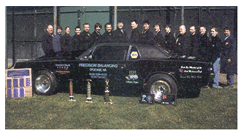After 75,000 miles, cars can begin to show their age. They may consume a bit more oil or oil could leak past intake valve stem seals. Higher mileage specialty motor oils typically contain additives that condition the rubber seals to help reduce oil consumption. They can also have high quality base oils that are less likely to evaporate when near the combustion chamber. An example of this type of specialty oil is Quaker State Higher Mileage Engine with Slick 50, which is specifically engineered to help reduce oil consumption.
Another way these specialty oils help provide performance is by helping provide a better seal around the aging piston rings by incorporating thicker oil viscosity.
Oils for Horsepower
After modifying their engines to boost horsepower, some auto enthusiasts look for a motor oil that provides the right balance among oil viscosity, oil flow and oil pressure to help free up as much horsepower as possible without sacrificing bearing life. Todays racing specialty oils, such as Q Racing, come in a variety of viscosity grades and also contain select friction modifiers that make the racing oil slippery to help free up more horsepower. Racing oils may also address the wear sometimes associated with stiffer valve springs added to help keep the valves from floating at higher rpm. These oils include additional anti-wear additives to compensate for the increased loads the stiffer springs place on the camshaft.
Courtesy of Quaker State.
Taming a Project Cougar
This 1967 Mercury Cougar project car, a collaboration of past, present and future students and faculty staff at Lewis Clark State College, Lewiston, ID, has been built for E/T Bracket Drag Racing.
 The Mercury Cougar, owned and operated by automotive professor Mike Hill, began as a school project car in 1998. The vehicle has seen numerous changes in its restoration, conversion and other challenges to allow it to compete in different classes.
The Mercury Cougar, owned and operated by automotive professor Mike Hill, began as a school project car in 1998. The vehicle has seen numerous changes in its restoration, conversion and other challenges to allow it to compete in different classes.
The engine is a 450 cu. in. 427 cross bolt main Ford FE with Scat rods and crankshaft, Diamond pistons and Edelbrock Performance 427 heads that are ported and polished. Other improvements include a Canton windage tray and oil pan, Competition Cams solid lifter cam, Harland Sharp Roller rocker arms, Edelbrock Victor 427 intake manifold, Holley 950 CFM Pro Series carburetor, Professional Products harmonic balancer and flex plate, Pro Gram main caps, ARP main studs, oil pump and drive shaft by Performance Oil Pumps with timing components by Extreme Racing Products. The Cougar has a C-6 transmission with a 4,500 rpm TCI converter, a nine-inch Ford rear differential with a 4.57 gear ratio. The roll cage was built by the Lewis Clark State College welding students, and the body and paint work was done by the schools collision repair program technicians.
Hill said the car runs 1/4-mile in 12 seconds at 112 MPH, and that it has competed in Spokane and Walla Walla, WA, as well as Portland, OR. We have won awards in the ISCA show car series, as well as winning in NHRA Pro Class. To date, more than 100 Lewis Clark students have worked on the car, and it continues to be prepared and maintained by our students, Hill said.











